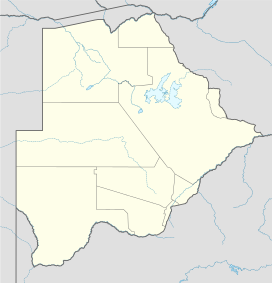| Sua Pan | |
|---|---|
| Geography | |
| Country | Botswana |
| District | Kalahari Desert |
| Population center | Sowa |
| Coordinates | 20°59′32″S 25°58′22″E / 20.99219°S 25.97289°E |
The Sua Pan or Sowa Pan is a large natural topographic depression within the Makgadikgadi region of Botswana. It is located near the village of Sowa, whose name means salt in the language of the San.[1][2] The Sua salt pan is one of three large pans within the Makgadikgadi, the other two being Nxai Pan and Nwetwe Pan.[3]
The Sua Pan was first described to the European world by David Livingstone, pursuant to his explorations in this region.[4] Significant archaeological recoveries have been made within the Nwetwe Pan, featuring Stone-Age tools from peoples who lived in this area[5] when a large year-round lake occupied the Sua and Nwetwe Pans.[6]
The Brines of Sua Pan being one of the largest playa lakes in the world spans approximately 24,000 square kilometers. While sodium chloride is the prime constituent, there are many other salts found within this area such as sodium carbonate, sodium bicarbonate, sodium sulfate, and minor amounts of potassium chloride (potash).[7]
Currently, Sua Pan is a seasonal lake; it fills with water during the Summer rainy season and retains water until April or May brought from the Nata River.[8] Among the more successful wildlife conservation projects in Botswana was the community-initiated Nata Bird Sanctuary in the northeast of this area. It opened in 1993 and was awarded that year the "Tourism for Tomorrow Award" for the Southern Hemisphere.[9] It is supported by members of four nearby villages, who have helped make it a success.
One of the tributaries of the Sua Pan is the Mosetse River. The village of Mosetse is named for it and lies along the river.
- ^ Sowa Pan Archived 2011-02-20 at the Wayback Machine. Botswana Tourism Board.
- ^ Murphy, Alan (2007). Southern Africa (4th ed.). Lonely Planet. p. 99. ISBN 978-1-74059-745-6. OCLC 156530975.
- ^ B.R. Davies, 1986
- ^ D. Livingstone, 1868
- ^ Jones, Sacha C.; Stewart, Brian A., eds. (2016). Africa from MIS 6-2: Population Dynamics and Paleoenvironments. Vertebrate Paleobiology and Paleoanthropology. Springer Netherlands. doi:10.1007/978-94-017-7520-5. ISBN 9789401775199. S2CID 12509903.
- ^ Burrough, Sallie L.; Thomas, David S.G.; Bailey, Richard M. (July 2009). "Mega-Lake in the Kalahari: A Late Pleistocene record of the Palaeolake Makgadikgadi system". Quaternary Science Reviews. 28 (15–16): 1392–1411. Bibcode:2009QSRv...28.1392B. doi:10.1016/j.quascirev.2009.02.007.
- ^ Republic of Botswana (November 24, 1980). "Botswana Soda-ash Study Contract No. AID/SOD/PDC-C-0407" (PDF). The Brines of Sua Pan. United States Agency for International Development.
- ^ "Makgadikgadi Pans Climate - Makgadikgadi Botswana". www.itravelto.com.
- ^ Chris McIntyre (2010). Botswana: Okavango Delta, Chobe, Northern Kalahari. Bradt Travel Guides. pp. 387–. ISBN 978-1-84162-308-5. Retrieved 12 April 2011.
